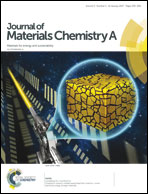N-Substituted poly(3,6-dithienylcarbazole) derivatives: a new class of redox-active electrode materials for high-performance flexible solid-state pseudocapacitors†
Abstract
Herein, we present the design and synthesis of novel poly(3,6-dithienylcarbazole) derivatives, namely poly(tert-butyl 2-(3,6-di(thiophen-2-yl)-9H-carbazol-9-yl)acetate) (PTTBCbz) and poly(tert-butyl 2-(3,6-bis(2,3-dihydrothieno[3,4-b][1,4]dioxin-5-yl)-9H-carbazol-9-yl)acetate) (PETBCbz), as redox-active materials for high performance electrochemical energy storage applications. Symmetric flexible solid-state pseudocapacitor devices were assembled by using PTTBCbz or PETBCbz and a polymer gel electrolyte based on LiClO4. The electrochemical characteristics of the pseudocapacitor devices were evaluated by cyclic voltammetry (CV), galvanostatic charge/discharge measurements (GCD) and electrochemical impedance spectroscopy (EIS). The fabricated supercapacitor devices delivered superior specific capacitances (Cspec = 640 F g−1 and Cspec = 554 F g−1), energy densities (E = 1280 W h kg−1 and E = 1108 W h kg−1) and power densities (P = 36 kW kg−1 and P = 32.7 kW kg−1). Furthermore, these flexible supercapacitors exhibited good cycling stability and excellent capacitance retentions (92.5% and 90.5%) after 10 000 successive charge/discharge cycles at a current density of 1 mA cm−2. The electrochemical characterization studies confirmed that these novel poly(3,6-dithienylcarbazole)-based redox-active materials have significant potential for utilization as redox-active electrode materials in high performance flexible and portable energy storage devices.


 Please wait while we load your content...
Please wait while we load your content...